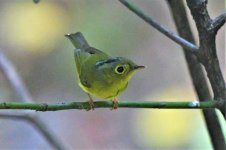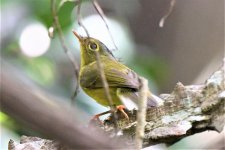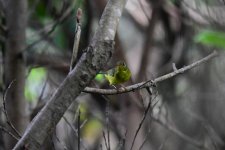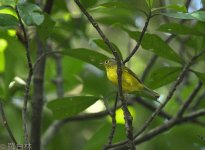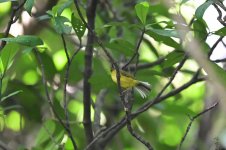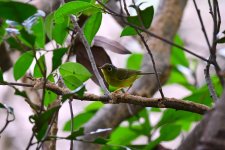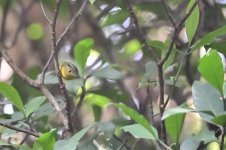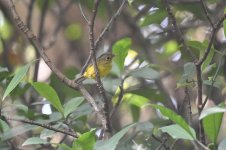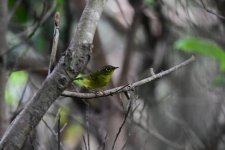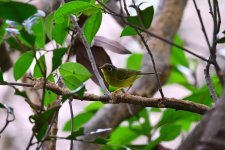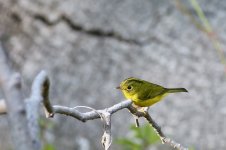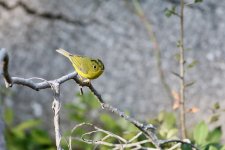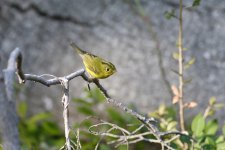There was a Warbler (previous Seicercus sp.) photographed by many birders few days ago in New Taipei City, Northern Taiwan. Some of the photos showed broken on top of the eye but others didn't. Unfortunately there was no any sound recorded. The tail pattern showed very white on R5 and R6 that seemed to be good to exclude some warblers, such as P. soror and P. omeiensis. According to the distinct wing bar and face pattern, we could limited the possibility to Bianchi's Warbler (Phylloscopus valentini latouchei) and White-spectacled Warbler (Phylloscopus intermedius intermedius). Is it possible to ID to species level if no more sound record? Thanks for any comments.
-
Welcome to BirdForum, the internet's largest birding community with thousands of members from all over the world. The forums are dedicated to wild birds, birding, binoculars and equipment and all that goes with it.
Please register for an account to take part in the discussions in the forum, post your pictures in the gallery and more.
You are using an out of date browser. It may not display this or other websites correctly.
You should upgrade or use an alternative browser.
You should upgrade or use an alternative browser.
Warbler ID in Norther Taiwan (1 Viewer)
- Thread starter modrawnu
- Start date
More options
Who Replied?Larry Sweetland
Formerly 'Larry Wheatland'
Looks like a Golden-spectacled Warbler (Seicercus burkii) Might be a 1st for Taiwan?
Cheers
Golden-spectacled has been split into a few species, some of which are mentioned as options by the OP Ken. burkii itself is now called Green-crowned, and is one of the more western forms much less likely to occur that far east. And (at least some) Seicercus have been chucked into Phylloscopus, including burkii.
Last edited:
KenM
Well-known member
Golden-spectacled has been split into a few species, some of which are mentioned as options by the OP Ken. burkii itself is now called Green-crowned, and is one of the more western forms much less likely to occur that far east. And (at least some) Seicercus have been chucked into Phylloscopus, including burkii.
Yes Larry thanks, I did note the split, however to my eye Burkii looked a reasonable match, whichever species it’s ascribed to it should create some interest being a long way from it’s Indian Wintering range?
Cheers
Yes Larry thanks, I did note the split, however to my eye Burkii looked a reasonable match, whichever species it’s ascribed to it should create some interest being a long way from it’s Indian Wintering range?
Cheers
Thanks for your comment, Ken.
In my opinion, the Green-cronwed Warbler (Phylloscopus burkii) often has a broken eye ring at rear which is not shown in our bird. Also, the black lateral crown stripe extends to bill base in burkii.
In Taiwan, we now have records of White-spectacled Warbler, Bianchi's Warbler, and Alström's Warbler. All of them are vagrant.
Nutcracker
Stop Brexit!
The whole of Seicercus has been merged into Phylloscopus :t:And (at least some) Seicercus have been chucked into Phylloscopus, including burkii.
There are now 6 species in the Golden-spectacled complex, two occurring on the Indian subcontinent (Whistler's, Green-crowned - which, as Larry pointed out, has assumed the old name burkii) and the other four occurring in China and/or N Indochina but wintering more widely (Grey-crowned, Bianchi's, Martens's and Alstrom's AKA Plain-tailed).
Green-crowned can be ruled out straight away, not only on distribution but also because it has a break at the rear of the rather weak eye-ring. Grey-crowned also has a break at the rear of the eye-ring and usually shows more grey below the lateral crown-stripe.
You would think, then, that it's one of the other Chinese species, but the bird definitely seems to have a break at the top left of its rather thick yellow eye-ring, although as modrawnu has pointed out, it seems less distinct in some images than others (are we quite sure all photos show the same individual?). Did the bird show this break in the field? This would suggest the Chinese race intermedius of White-spectacled Warbler, which actually has a thick yellow eye-ring as on the OP bird, unlike the other two races. It also appears from the spread tail shots that there's too much white on R5 for Bianchi's and possibly some on R4 too, which would doubly rule it out, and I'm pretty sure rules out Marten's and Alstrom's. I am comparing the tail pattern, by the way, with the excellent images on a PowerPoint adapted from an Ibis article - it's too big to attach here, but click on this link:
https://www.yumpu.com/en/document/r...ctacled-warblers-a-complex-of-cryptic-species
By the way, putting these warblers in Phylloscopus makes no sense to me.
I'm hoping John Allcock can chip in on this one.
Green-crowned can be ruled out straight away, not only on distribution but also because it has a break at the rear of the rather weak eye-ring. Grey-crowned also has a break at the rear of the eye-ring and usually shows more grey below the lateral crown-stripe.
You would think, then, that it's one of the other Chinese species, but the bird definitely seems to have a break at the top left of its rather thick yellow eye-ring, although as modrawnu has pointed out, it seems less distinct in some images than others (are we quite sure all photos show the same individual?). Did the bird show this break in the field? This would suggest the Chinese race intermedius of White-spectacled Warbler, which actually has a thick yellow eye-ring as on the OP bird, unlike the other two races. It also appears from the spread tail shots that there's too much white on R5 for Bianchi's and possibly some on R4 too, which would doubly rule it out, and I'm pretty sure rules out Marten's and Alstrom's. I am comparing the tail pattern, by the way, with the excellent images on a PowerPoint adapted from an Ibis article - it's too big to attach here, but click on this link:
https://www.yumpu.com/en/document/r...ctacled-warblers-a-complex-of-cryptic-species
By the way, putting these warblers in Phylloscopus makes no sense to me.
I'm hoping John Allcock can chip in on this one.
Last edited:
Brian J Small
Well-known member
A smart bird!
With that amount of white in the tail - added to by the wing bar - it would seem to fit valentini best...
https://www.slu.se/globalassets/ew/...acled-warblers/golden-spectacled-warblers.pdf - a different link to same article as above.
Voice would certainly help and without it, this may ultimately not be assigned to species.
Brian S
With that amount of white in the tail - added to by the wing bar - it would seem to fit valentini best...
https://www.slu.se/globalassets/ew/...acled-warblers/golden-spectacled-warblers.pdf - a different link to same article as above.
Voice would certainly help and without it, this may ultimately not be assigned to species.
Brian S
Nutcracker
Stop Brexit!
They're embedded deep within Phylloscopus, and not all in one group - if you want to keep Seicercus as a genus, you'd need to split up the rest of Phylloscopus into several genera (5 or 6 genera IIRC), and Seicercus itself into at least 2 genera.By the way, putting these warblers in Phylloscopus makes no sense to me.
You would think, then, that it's one of the other Chinese species, but the bird definitely seems to have a break at the top left of its rather thick yellow eye-ring, although as modrawnu has pointed out, it seems less distinct in some images than others (are we quite sure all photos show the same individual?). Did the bird show this break in the field? This would suggest the Chinese race intermedius of White-spectacled Warbler, which actually has a thick yellow eye-ring as on the OP bird, unlike the other two races. It also appears from the spread tail shots that there's too much white on R5 for Bianchi's and possibly some on R4 too, which would doubly rule it out, and I'm pretty sure rules out Marten's and Alstrom's. I am comparing the tail pattern, by the way, with the excellent images on a PowerPoint adapted from an Ibis article - it's too big to attach here, but click on this link:
Thank you very much, Andy.
By my friends' statement, they only saw one warbler like this in the two days in the same small area. And nobody could make sure the eye ring condition in the field because it was so actively jumping in the branches and leaves.
If it pointed to White-spectacled Warbler, it still seems so strange of its black lateral crown stripe, that only reached to the top of the eye but not to the bill base, which is more c/w Bianchi's. I've personally seen one White-spectacled Warbler in Kinmen island, Taiwan, but very closed to mainland China(pictures shown in the attachment). In that experience, the black lateral crown stripe is distinct reaching to bill base and also the obvious yellow eye ring broken on the top of the eye. I was told by experienced birder, my Kinmen bird is "cognitus" morph, which has greenish medium crown but not gray in "intermedius" morph. Now, I'm still confused with this two different morphs. Are they only different in the crown color? Or also the lateral crown stripe, and/or the eye ring broken condition ?
Attachments
Last edited:
According to an article in the Hong Kong Bird Report for 2014, there are two morphs of intermedius, a grey-headed one and a green-headed one (John Allcock passed a copy onto me, but I wouldn't share it without his permission). Your Kinmen bird seems to be a well-marked green-headed morph. Looking at some images, the head of green-headed individuals is not always that well-marked, but you might expect a grey-headed morph to have more a distinct lateral crown stripe than the OP bird, especially on the forecrown.
The Kinmen bird offers a useful comparison - it seems brighter yellow underneath than the OP bird and has a more distinct greater covert bar as well as a faint median covert bar. The eye-ring doesn't seem much thicker than that of the OP bird and again, the break shows better from some angles than others, but it is there. I'm less confident that the OP bird has a break - it may just be that it's diffuse, and that it's Bianchi's after all, as Brian suggested. On the other hand, there's still a lot of white in the outer tail.
Part of the reason I suggested WSW was that I helped a friend to identify one he photographed in NW Vietnam. Again, I don't feel comfortable sharing the images without his permission.
The Kinmen bird offers a useful comparison - it seems brighter yellow underneath than the OP bird and has a more distinct greater covert bar as well as a faint median covert bar. The eye-ring doesn't seem much thicker than that of the OP bird and again, the break shows better from some angles than others, but it is there. I'm less confident that the OP bird has a break - it may just be that it's diffuse, and that it's Bianchi's after all, as Brian suggested. On the other hand, there's still a lot of white in the outer tail.
Part of the reason I suggested WSW was that I helped a friend to identify one he photographed in NW Vietnam. Again, I don't feel comfortable sharing the images without his permission.
They're embedded deep within Phylloscopus, and not all in one group - if you want to keep Seicercus as a genus, you'd need to split up the rest of Phylloscopus into several genera (5 or 6 genera IIRC), and Seicercus itself into at least 2 genera.
I mean it makes no sense visually!
Larry Sweetland
Formerly 'Larry Wheatland'
I mean it makes no sense visually!
With you there!
johnallcock
Well-known member
According to an article in the Hong Kong Bird Report for 2014, there are two morphs of intermedius, a grey-headed one and a green-headed one (John Allcock passed a copy onto me, but I wouldn't share it without his permission).
For those interested, the article is available online here: https://www.hkbws.org.hk/web/chi/documents/bird_report/2014_birdreport_protected.pdf
It concerns the ID of taxa occurring in Hong Kong, so doesn't cover everything in India/Western China, but it should be relevant to the birds seen in Taiwan.
I find this to be an interesting bird. I think the main confusion is the result of the eye-ring shape. On most photos does look broken at the front like on White-spectacled, but if you look at some of the closer photos (especially the first one posted) you can actually see a trace of the eye-ring here and some untidy feathers nearby. I wonder if it is affected by moult on this bird, changing the appearance from the true shape.
Apart from the eye-ring, I don't think other features on this bird fit with White-spectacled. Structurally WsW should look fairly large-headed/short-tailed (a bit like a Pallas's Warbler), which this bird doesn't (compare to your Kinmen bird). The wing bar is fairly indistinct and the underparts are not as bright as I'd expect on WsW, with a greenish wash on the sides of the breast.
As Brian suggests, the wing bar and white in the tail suggest it's a Bianchi's (valentini). The confusion here is Martens' (omeiensis) - as far as I know there is no reliable way to separate these two species in the field, except by voice. Bianchi's seems more likely to occur on Taiwan, as it breeds further east, but Martens' has occurred in Hong Kong a few times so I'm not sure it can be completely ruled out as a possibility.
Among the other two central Chinese species, Alstrom's should have less white in the tail than this bird, and I think would also have a slightly heavier bill (more like an Arctic Warbler) and duller underparts. Grey-crowned should have a clear break in the rear of the eye-ring and I think should show a more contrasting head pattern, with black lateral stripes and more grey in the crown.
Thanks for this, John. I'd been hoping that you might chip in on this thread. I revised my initial view a while back and agree it's not WSW.
Assuming the illustration of the pattern of white on the outer tail feathers in the presentation I linked is accurate, I'd say that the 3rd image of the OP bird shows too much white on R5(?) - there's a long tongue of white almost the same length as the one on R6, surely too long for Martens's and better for Bianchi's.
Assuming the illustration of the pattern of white on the outer tail feathers in the presentation I linked is accurate, I'd say that the 3rd image of the OP bird shows too much white on R5(?) - there's a long tongue of white almost the same length as the one on R6, surely too long for Martens's and better for Bianchi's.
Users who are viewing this thread
Total: 2 (members: 0, guests: 2)




